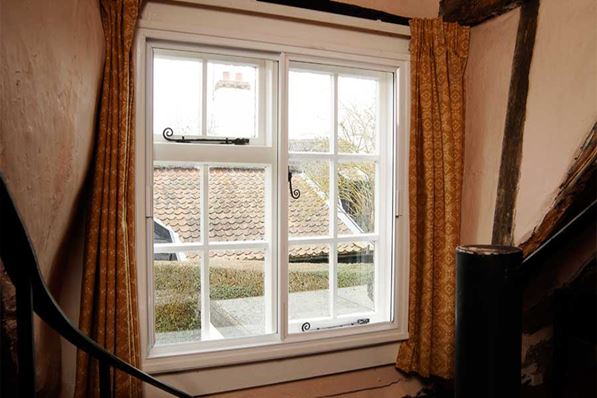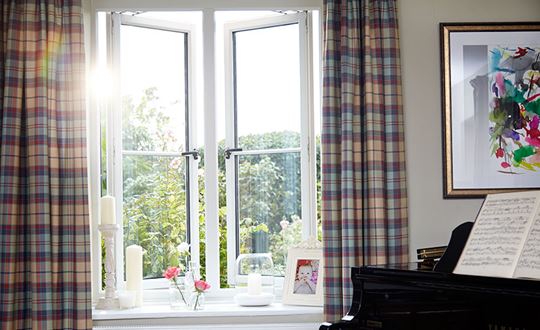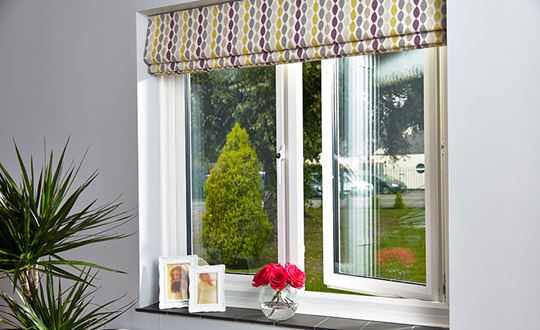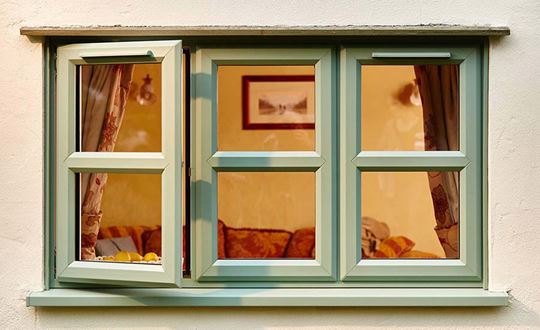If you’re looking for a way to improve the energy efficiency, reduce outside noise, make your home more secure or all of the above, then double or triple glazing are great options.
Read on to find out the science behind how double glazing and triple glazing work, the ins and outs of their energy ratings and how improving your windows will help you save money.
Installing double glazed windows is essential when you want to retain as much heat as possible in your home, but how exactly does it work?
Double glazing uses two panes of glass separated by a layer of argon gas, forming a sealed unit known as an insulated glass unit (IGU). The layer of argon gas has a lower thermal conductivity than air, making it a poor conductor of heat. The inner pane of glass is Low-E glass, which is treated to lower thermal transference through the glass.
Double glazing creates an insulating space between the panes of glass on the inside and outside of the window. This space is sealed and filled with inert argon gas, which provides more insulation than air. The gas lowers convection, helping trap heat inside and keep the cold air outside.
Most companies also use Low-E glass for the inner pane. This glass is treated so that it further slows heat transfer. That means less heat escapes the inside of the window to the outside.
Together, the glass and the gas make it much harder for heat to pass through the window to the outside. In turn, it reduces how much the cold can penetrate from the outer pane to the inner pane. This helps make your home warmer in winter, reducing how much heating you use, making your home more energy-efficient.
Double glazed windows help to reduce heat loss through the sealed, insulating space between the two panes of glass.
Instead of warm air transferring straight through a single pane of glass to be lost outside, the heat instead transfers to the argon gas inside the sealed unit. The gas slows down the temperature transfer so the warmth is mostly retained inside your home.
Likewise, the argon gas creates a barrier between the cold air outside and the inside of the room, helping to keep the sealed space at a median temperature in between.
Modern double glazed windows have an excellent lifespan. If you installed a double-glazed window today, you can expect it to last around 20 to 25 years, depending on its location.
For example, a double glazed window that is more sheltered from the weather will typically last longer than a window that’s very exposed to the weather. The lifespan of a modern double-glazed window can also be extended by good care and maintenance. This can be as simple as regularly checking for wear, or keeping hinges oiled and free of debris.
Condensation occurs when water molecules get closer together as they get colder, such as on the surface of a cold window pane. As the molecules get closer together, they form visible drops of water, which we see as condensation.
Double glazing reduces condensation because the inner pane of glass is a similar temperature to your room. This is due to the insulation provided by the Low-E glass and the argon gas. So as long as your room is at a warm temperature, the internal glass will be too, lowering the chance of condensation forming.
The space between the glass has an airtight seal, so condensation doesn't form inside it. The space is also treated with crystalline desiccant to absorb excess moisture. So if you see condensation inside your double glazing, it means that you need to have it replaced.
Argon gas is used in double glazed windows because it is a good insulator. Compared with air, argon gas conducts much less heat, so it slows the transfer of heat from inside your house through your windows. Argon is a naturally occurring, harmless gas, also used in products such as light bulbs and some car tyres.
Triple glazing is a window with three panes of glass and two insulating sealed spaces, offering the ultimate energy efficiency.
The frame includes a thermal insert in the mainframe chamber to create smaller chambers and reduce heat loss. There’s a spacer bar between each pane of glass which is made from a thermally optimised insulating material, which also prevents heat from escaping around the edge of the sealed unit.
Argon gas is used in the space between the panes to provide excellent insulation and reduce the loss of heat through the windows.
Learn more about triple glazing.
Triple glazing uses the same principles as double glazing but adds an extra pane of glass and another sealed space between to provide even more heat retention. Two of the glass panes are Low E and one is Low Iron, further helping to reduce heat loss and reflect warmth into the room.
The edges of each sealed unit also feature a spacer bar to stop heat from escaping, while the gaps are filled with argon gas to provide the main insulating effect.
All these features work together to create a highly energy-efficient design, helping to retain warmth in your home and reduce your heating bills.
Triple glazed windows can have a long lifespan, anywhere from 20 to 25 years depending on how sheltered their location is. A triple glazed window facing away from prevailing winds and weather will likely last longer, while a window that’s more exposed to the weather might last closer to 20 years.
The important thing is to keep them well-maintained to give them the proper care so they last as long as possible.
Thanks to its three layers of glass, a triple glazed window has the added benefit of providing greater security. The extra layer of glass makes the window harder to break through than double glazing, helping to keep out any would-be intruders and protecting against accidental damage.

Secondary glazing provides a solution for homes that are unable to install double or triple glazing due to the structure of their home. They are also useful for listed properties and homes in a conservation area that require special planning permissions for changes.
Secondary glazing improves the energy efficiency of existing windows by adding window glass behind the existing window. The subtle and slim sliding units can work for a wide range of window styles and sizes.
Secondary glazing takes the principle of double and triple glazing to add an insulating effect to any window. It creates a sealed air pocket between the existing window and the inside of your home.
This air space does a similar job to the space between panes of glass in double and triple glazing, stopping warm air escaping and cold air entering.
It’s like putting on a jumper or a coat - adding that extra layer to trap a cushion of air to keep the heat inside.
All double and triple glazed windows have energy ratings. These energy ratings let you know how well a window will retain heat, expressed as a rating from E to A++.
Windows with an A++ rating are the best performing, while a window with a rating lower than B will be losing more energy than it saves. This is why all of our double glazing achieves a B-rating or higher, with the majority rated A and above.
Learn more about window energy efficiency by glazing type
Secondary, double and triple glazing offer excellent energy efficiency for your home, helping to keep in the warmth and reduce the burden on your central heating. What is best for your home will depend on your specific circumstances, which is where our experts come in.
Get in touch with us today to talk about secondary, double or triple glazing for your home.
 How much do double glazed windows cost?
How much do double glazed windows cost?
All in all, how much will a warmer, more secure home cost you? How much is worth investing in double glazed windows? We break it down for you.
 Should you get double or triple glazing?
Should you get double or triple glazing?
Double and triple glazed windows are energy efficient, but which type should you choose? Double and triple glazing insulate the home and increase security, but each have their own advantages. Read on to find out which is most suitable for you.
 Choosing the right window material & colour
Choosing the right window material & colour
Complete your windows with uPVC, wooden or aluminium frames, available in a wide range of colours and finishes. And if you simply can't choose, we're here to help you discover which designs will be most complementary to your home.


